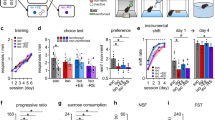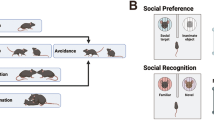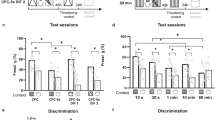Abstract
Overcoming specific fears and subsequent anxiety can be greatly enhanced by the presence of familiar social partners, but the neural circuitry that controls this phenomenon remains unclear. To overcome this, the social interaction (SI) habituation test was developed in this lab to systematically investigate the effects of social familiarity on anxiety-like behavior in rats. Here, we show that social familiarity selectively reduced anxiety-like behaviors induced by an ethological anxiogenic stimulus. The anxiolytic effect of social familiarity could be elicited over multiple training sessions and was specific to both the presence of the anxiogenic stimulus and the familiar social partner. In addition, socially familiar conspecifics served as a safety signal, as anxiety-like responses returned in the absence of the familiar partner. The expression of the social familiarity-induced anxiolysis (SFiA) appears dependent on the prefrontal cortex (PFC), an area associated with cortical regulation of fear and anxiety behaviors. Inhibition of the PFC, with bilateral injections of the GABAA agonist muscimol, selectively blocked the expression of SFiA while having no effect on SI with a novel partner. Finally, the effect of D-cycloserine, a cognitive enhancer that clinically enhances behavioral treatments for anxiety, was investigated with SFiA. D-cycloserine, when paired with familiarity training sessions, selectively enhanced the rate at which SFiA was acquired. Collectively, these outcomes suggest that the PFC has a pivotal role in SFiA, a complex behavior involving the integration of social cues of familiarity with contextual and emotional information to regulate anxiety-like behavior.
Similar content being viewed by others
Log in or create a free account to read this content
Gain free access to this article, as well as selected content from this journal and more on nature.com
or
References
Adolphs R (2009). The social brain: neural basis of social knowledge. Annu Rev Psychol 60: 693–716.
Adolphs R (2010). Conceptual challenges and directions for social neuroscience. Neuron 65: 752–767.
Amodio DM, Frith CD (2006). Meeting of minds: the medial frontal cortex and social cognition. Nat Rev Neurosci 7: 268–277.
Baldwin SA, Wampold BE, Imel ZE (2007). Untangling the alliance-outcome correlation: exploring the relative importance of therapist and patient variability in the alliance. J Consult Clin Psychol 75: 842–852.
Bishop S, Duncan J, Brett M, Lawrence AD (2004). Prefrontal cortical function and anxiety: controlling attention to threat-related stimuli. Nat Neurosci 7: 184–188.
Chang CH, Maren S (2011). Medial prefrontal cortex activation facilitates re-extinction of fear in rats. Learn Mem 18: 221–225.
Christianson JP, Fernando AB, Kazama AM, Jovanovic T, Ostroff LE, Sangha S (2012). Inhibition of fear by learned safety signals: a mini-symposium review. J Neurosci 32: 14118–14124.
Coan JA, Schaefer HS, Davidson RJ (2006). Lending a hand: social regulation of the neural response to threat. Psychol Sci 17: 1032–1039.
Cohen S (2004). Social relationships and health. Am Psychol 59: 676–684.
Crawley J, Goodwin FK (1980). Preliminary report of a simple animal behavior model for the anxiolytic effects of benzodiazepines. Pharmacol Biochem Behav 13: 167–170.
Davis M, Ressler K, Rothbaum BO, Richardson R (2006). Effects of D-cycloserine on extinction: translation from preclinical to clinical work. Biol Psychiatry 60: 369–375.
Davitz JR, Mason DJ (1955). Socially facilitated reduction of a fear response in rats. J Comp Physiol Psychol 48: 149–151.
de Jongh R, Groenink L, van Der Gugten J, Olivier B (2002). The light-enhanced startle paradigm as a putative animal model for anxiety: effects of chlordiazepoxide, flesinoxan and fluvoxamine. Psychopharmacology 159: 176–180.
DeFries JC, Hegmann JP, Weir MW (1966). Open-field behavior in mice: evidence for a major gene effect mediated by the visual system. Science 154: 1577–1579.
DeVries AC, Glasper ER, Detillion CE (2003). Social modulation of stress responses. Physiol Behav 79: 399–407.
Eisenberger NI, Master SL, Inagaki TK, Taylor SE, Shirinyan D, Lieberman MD et al (2011). Attachment figures activate a safety signal-related neural region and reduce pain experience. Proc Natl Acad Sci USA 108: 11721–11726.
File SE, Hyde JR (1978). Can social interaction be used to measure anxiety? Br J Pharmacol 62: 19–24.
Fossati P (2012). Neural correlates of emotion processing: from emotional to social brain. Eur Neuropsychopharmacol 22 (Suppl 3): S487–S491.
Ganasen KA, Ipser JC, Stein DJ (2010). Augmentation of cognitive behavioral therapy with pharmacotherapy. Psychiatr Clin North Am 33: 687–699.
Gupta SC, Hillman BG, Prakash A, Ugale RR, Stairs DJ, Dravid SM (2013). Effect of D-cycloserine in conjunction with fear extinction training on extracellular signal-regulated kinase activation in the medial prefrontal cortex and amygdala in rat. Eur J Neurosci 37: 1811–1822.
Hartley CA, Phelps EA (2010). Changing fear: the neurocircuitry of emotion regulation. Neuropsychopharmacology 35: 136–146.
Hennessy MB, Maken DS, Graves FC (2000). Consequences of the presence of the mother or unfamiliar adult female on cortisol, ACTH, testosterone and behavioral responses of periadolescent guinea pigs during exposure to novelty. Psychoneuroendocrinology 25: 619–632.
Hennessy MB, O'Leary SK, Hawke JL, Wilson SE (2002). Social influences on cortisol and behavioral responses of preweaning, periadolescent, and adult guinea pigs. Physiol Behav 76: 305–314.
Herry C, Mons N (2004). Resistance to extinction is associated with impaired immediate early gene induction in medial prefrontal cortex and amygdala. Eur J Neurosci 20: 781–790.
Hofmann SG, Meuret AE, Smits JA, Simon NM, Pollack MH, Eisenmenger K et al (2006a). Augmentation of exposure therapy with D-cycloserine for social anxiety disorder. Arch Gen Psychiatry 63: 298–304.
Hofmann SG, Pollack MH, Otto MW (2006b). Augmentation treatment of psychotherapy for anxiety disorders with D-cycloserine. CNS Drug Rev 12: 208–217.
Hofmann SG, Smits JA, Rosenfield D, Simon N, Otto MW, Meuret AE et al (2013). d-Cycloserine as an augmentation strategy with cognitive-behavioral therapy for social anxiety disorder. Am J Psychiatry 170: 751–758.
Holmes AJ, Lee PH, Hollinshead MO, Bakst L, Roffman JL, Smoller JW et al (2012). Individual differences in amygdala-medial prefrontal anatomy link negative affect, impaired social functioning, and polygenic depression risk. J Neurosci 32: 18087–18100.
Jacome LF, Burket JA, Herndon AL, Deutsch SI (2011). D-Cycloserine enhances social exploration in the Balb/c mouse. Brain Res Bull 85: 141–144.
Kalisch R, Korenfeld E, Stephan KE, Weiskopf N, Seymour B, Dolan RJ (2006). Context-dependent human extinction memory is mediated by a ventromedial prefrontal and hippocampal network. J Neurosci 26: 9503–9511.
Kim MJ, Gee DG, Loucks RA, Davis FC, Whalen PJ (2011a). Anxiety dissociates dorsal and ventral medial prefrontal cortex functional connectivity with the amygdala at rest. Cereb Cortex 21: 1667–1673.
Kim MJ, Loucks RA, Palmer AL, Brown AC, Solomon KM, Marchante AN et al (2011b). The structural and functional connectivity of the amygdala: From normal emotion to pathological anxiety. Behav Brain Res 223: 403–410.
Kiyokawa Y, Takeuchi Y, Mori Y (2007). Two types of social buffering differentially mitigate conditioned fear responses. Eur J Neurosci 26: 3606–3613.
Kiyokawa Y, Takeuchi Y, Nishihara M, Mori Y (2009). Main olfactory system mediates social buffering of conditioned fear responses in male rats. Eur J Neurosci 29: 777–785.
Kiyokawa Y, Wakabayashi Y, Takeuchi Y, Mori Y (2012). The neural pathway underlying social buffering of conditioned fear responses in male rats. Eur J Neurosci 36: 3429–3437.
Knapska E, Macias M, Mikosz M, Nowak A, Owczarek D, Wawrzyniak M et al (2012). Functional anatomy of neural circuits regulating fear and extinction. Proc Natl Acad Sci USA 109: 17093–17098.
Knapska E, Maren S (2009). Reciprocal patterns of c-Fos expression in the medial prefrontal cortex and amygdala after extinction and renewal of conditioned fear. Learn Mem 16: 486–493.
Latane B (1969). Gregariousness and fear in laboratory rats. J Exp Soc Psychol 5: 61–69.
Laurent V, Westbrook RF (2009). Inactivation of the infralimbic but not the prelimbic cortex impairs consolidation and retrieval of fear extinction. Learn Mem 16: 520–529.
Ledgerwood L, Richardson R, Cranney J (2003). Effects of D-cycloserine on extinction of conditioned freezing. Behav Neurosci 117: 341–349.
Maren S, Quirk GJ (2004). Neuronal signalling of fear memory. Nat Rev Neurosci 5: 844–852.
Martin DJ, Garske JP, Davis MK (2000). Relation of the therapeutic alliance with outcome and other variables: a meta-analytic review. J Consult Clin Psychol 68: 438–450.
McHugh RK, Whitton SW, Peckham AD, Welge JA, Otto MW (2013). Patient preference for psychological vs pharmacologic treatment of psychiatric disorders: a meta-analytic review. J Clin Psychiatry 74: 595–602.
Meyer-Lindenberg A, Tost H (2012). Neural mechanisms of social risk for psychiatric disorders. Nat Neurosci 15: 663–668.
Milad MR, Quirk GJ (2002). Neurons in medial prefrontal cortex signal memory for fear extinction. Nature 420: 70–74.
Milad MR, Wright CI, Orr SP, Pitman RK, Quirk GJ, Rauch SL (2007). Recall of fear extinction in humans activates the ventromedial prefrontal cortex and hippocampus in concert. Biol Psychiatry 62: 446–454.
Myers KM, Carlezon WA Jr. (2012). D-cycloserine effects on extinction of conditioned responses to drug-related cues. Biol Psychiatry 71: 947–955.
Nakayasu T, Kato K (2011). Is full physical contact necessary for buffering effects of pair housing on social stress in rats? Behav Processes 86: 230–235.
Paxinos G, Watson C (2005) The Rat Brain in Stereotaxic Coordinates 5th edn. Elsevier Academic Press: Amsterdam; Boston, USA.
Peters J, Dieppa-Perea LM, Melendez LM, Quirk GJ (2010). Induction of fear extinction with hippocampal-infralimbic BDNF. Science 328: 1288–1290.
Pezawas L, Meyer-Lindenberg A, Drabant EM, Verchinski BA, Munoz KE, Kolachana BS et al (2005). 5-HTTLPR polymorphism impacts human cingulate-amygdala interactions: a genetic susceptibility mechanism for depression. Nat Neurosci 8: 828–834.
Phelps EA, Delgado MR, Nearing KI, LeDoux JE (2004). Extinction learning in humans: role of the amygdala and vmPFC. Neuron 43: 897–905.
Rainnie DG, Bergeron R, Sajdyk TJ, Patil M, Gehlert DR, Shekhar A (2004). Corticotrophin releasing factor-induced synaptic plasticity in the amygdala translates stress into emotional disorders. J Neurosci 24: 3471–3479.
Roshanaei-Moghaddam B, Pauly MC, Atkins DC, Baldwin SA, Stein MB, Roy-Byrne P (2011). Relative effects of CBT and pharmacotherapy in depression versus anxiety: is medication somewhat better for depression, and CBT somewhat better for anxiety? Depress Anxiety 28: 560–567.
Sajdyk TJ, Gehlert DR (2000). Astressin, a corticotropin releasing factor antagonist, reverses the anxiogenic effects of urocortin when administered into the basolateral amygdala. Brain Res 877: 226–234.
Sanders SK, Shekhar A (1995a). Anxiolytic effects of chlordiazepoxide blocked by injection of GABAA and benzodiazepine receptor antagonists in the region of the anterior basolateral amygdala of rats. Biol Psychiatry 37: 473–476.
Sanders SK, Shekhar A (1995b). Regulation of anxiety by GABAA receptors in the rat amygdala. Pharmacol Biochem Behav 52: 701–706.
Santini E, Sepulveda-Orengo M, Porter JT (2012). Muscarinic receptors modulate the intrinsic excitability of infralimbic neurons and consolidation of fear extinction. Neuropsychopharmacology 37: 2047–2056.
Schiller D, Levy I, Niv Y, LeDoux JE, Phelps EA (2008). From fear to safety and back: reversal of fear in the human brain. J Neurosci 28: 11517–11525.
Shekhar A (1994). Effects of treatment with imipramine and clonazepam on an animal model of panic disorder. Biol Psychiatry 36: 748–758.
Shekhar A, Katner JS (1995). Dorsomedial hypothalamic GABA regulates anxiety in the social interaction test. Pharmacol Biochem Behav 50: 253–258.
Shekhar A, Keim SR, Simon JR, McBride WJ (1996). Dorsomedial hypothalamic GABA dysfunction produces physiological arousal following sodium lactate infusions. Pharmacol Biochem Behav 55: 249–256.
Shekhar A, Sajdyk T, Rainnie D, Gehlert D (eds) (2002). CRF-Induced Plasticity in the Amygdala: A Putative Link Between Stress and Human Illnesses. 4th World Congress on Stress September 12th-15th; Edinburgh, UK Taylor and Francis, Ltd: Edinburgh, UK.
Sierra-Mercado D, Padilla-Coreano N, Quirk GJ (2011). Dissociable roles of prelimbic and infralimbic cortices, ventral hippocampus, and basolateral amygdala in the expression and extinction of conditioned fear. Neuropsychopharmacology 36: 529–538.
Sotres-Bayon F, Quirk GJ (2010). Prefrontal control of fear: more than just extinction. Curr Opin Neurobiol 20: 231–235.
Spikman JM, Timmerman ME, Milders MV, Veenstra WS, van der Naalt J (2012). Social cognition impairments in relation to general cognitive deficits, injury severity, and prefrontal lesions in traumatic brain injury patients. J Neurotrauma 29: 101–111.
Strodl MA, Schausberger P (2012). Social familiarity reduces reaction times and enhances survival of group-living predatory mites under the risk of predation. PloS One 7: e43590.
Terranova ML, Cirulli F, Laviola G (1999). Behavioral and hormonal effects of partner familiarity in periadolescent rat pairs upon novelty exposure. Psychoneuroendocrinology 24: 639–656.
Thielen SK, Shekhar A (2002). Amygdala priming results in conditioned place avoidance. Pharmacol Biochem Behav 71: 401–406.
Thompson BM, Baratta MV, Biedenkapp JC, Rudy JW, Watkins LR, Maier SF (2010). Activation of the infralimbic cortex in a fear context enhances extinction learning. Learn Mem 17: 591–599.
Truitt WA, Sajdyk TJ, Dietrich AD, Oberlin B, McDougle CJ, Shekhar A (2007). From anxiety to autism: spectrum of abnormal social behaviors modeled by progressive disruption of inhibitory neuronal function in the basolateral amygdala in Wistar rats. Psychopharmacology 191: 107–118.
van Kerkhof LW, Damsteegt R, Trezza V, Voorn P, Vanderschuren LJ (2013a). Social play behavior in adolescent rats is mediated by functional activity in medial prefrontal cortex and striatum. Neuropsychopharmacology 38: 1899–1909.
van Kerkhof LW, Trezza V, Mulder T, Gao P, Voorn P, Vanderschuren LJ (2013b). Cellular activation in limbic brain systems during social play behaviour in rats. Brain Struct Funct (e-pub ahead of print).
Walker DL, Davis M (1997). Anxiogenic effects of high illumination levels assessed with the acoustic startle response in rats. Biol Psychiatry 42: 461–471.
Walker DL, Ressler KJ, Lu KT, Davis M (2002). Facilitation of conditioned fear extinction by systemic administration or intra-amygdala infusions of D-cycloserine as assessed with fear-potentiated startle in rats. J Neurosci 22: 2343–2351.
Watson GB, Bolanowski MA, Baganoff MP, Deppeler CL, Lanthorn TH (1990). D-cycloserine acts as a partial agonist at the glycine modulatory site of the NMDA receptor expressed in Xenopus oocytes. Brain Res 510: 158–160.
Author information
Authors and Affiliations
Corresponding author
Rights and permissions
About this article
Cite this article
Lungwitz, E., Stuber, G., Johnson, P. et al. The Role of the Medial Prefrontal Cortex in Regulating Social Familiarity-Induced Anxiolysis. Neuropsychopharmacol 39, 1009–1019 (2014). https://doi.org/10.1038/npp.2013.302
Received:
Revised:
Accepted:
Published:
Issue date:
DOI: https://doi.org/10.1038/npp.2013.302
Keywords
This article is cited by
-
Liposaccharide-induced sustained mild inflammation fragments social behavior and alters basolateral amygdala activity
Psychopharmacology (2023)
-
Optogenetic reactivation of prefrontal social neural ensembles mimics social buffering of fear
Neuropsychopharmacology (2020)
-
Adolescent THC Exposure Causes Enduring Prefrontal Cortical Disruption of GABAergic Inhibition and Dysregulation of Sub-Cortical Dopamine Function
Scientific Reports (2017)



